 Le Dr Robert MacGregor, président de l'ADC (extrême gauche), et Dave Hancin, vice-président and directeur général, DENTSPLY Canada (extrême droite), avec les participants au Programme de recherche des cliniciens étudiants ADC/DENTSPLY 2011.
Le Dr Robert MacGregor, président de l'ADC (extrême gauche), et Dave Hancin, vice-président and directeur général, DENTSPLY Canada (extrême droite), avec les participants au Programme de recherche des cliniciens étudiants ADC/DENTSPLY 2011.
Le Programme de recherche des cliniciens étudiants ADC/DENTSPLY 2011 a eu lieu à Halifax en août pendant le congrès annuel de l'ADC. Ce concours national de recherche clinique invite des étudiants des 10 facultés de médecine dentaire agréées du Canada à présenter devant des juges qualifiés des démonstrations cliniques de leurs travaux de recherche.
Simon Jean, de l'Université de Montréal, a été nommé gagnant du programme 2011 pour son étude des mécanismes qui entrent en jeu dans le déclenchement et le maintien de la douleur musculaire buccofaciale chronique. Son premier prix lui donne droit à un voyage tous frais compris au prochain congrès annuel de l'Association dentaire américaine (ADA) à Las Vegas, au Nevada, pour y présenter sa recherche dans le cadre du programme scientifique de l'ADA.
«La participation à ce programme a constitué une expérience enrichissante parce qu'elle m'a donné l'occasion de partager mes découvertes avec autrui, ce que je considère comme une partie principale de la recherche scientifique, explique M. Jean. C'était formidable d'échanger avec d'autres étudiants parce que j'ai compris que je n'étais pas le seul à penser que la recherche est la clé pour améliorer la pratique clinique.»
Dans le concours de cette année, Erin McDonald, de l'Université Western Ontario, s'est classée deuxième. Ses travaux visaient à déterminer si l'histatine 1 demeure intacte dans l'environnement protéolytique des liquides buccaux. «C'était vraiment stimulant de voir des travaux de recherche de tout genre effectués à travers le pays ainsi que la façon dont mes camarades étudiants se passionnaient pour leurs projets», fait-elle remarquer. Son prix consiste en une somme de 1000 $ versée par Dentsply.
Depuis plus de 40 années, la société DENTSPLY commandite le Programme de recherche des cliniciens étudiants qui a pour but «de susciter des idées, d'améliorer les communications et, par-dessus tout, d'accroître la participation des étudiants au progrès de la profession dentaire».
La division canadienne de l'Académie Pierre Fauchard rend également hommage aux cliniciens étudiants qui participent au concours en leur présentant une bourse pour reconnaître les efforts spéciaux qu'ils déploient en vue de promouvoir l'éducation dentaire indépendamment de leurs carrières universitaires.
Le Dr Euan Swan, chef des programmes dentaires de l'ADC, et le Dr Bernard Dolansky, ancien président de l'ADC, étaient les juges officiels à la rencontre d'Halifax.
++++++
Le JADC a le plaisir de publier une version condensée des sommaires qui ont été présentés dans la cadre du Programme de recherche des cliniciens étudiants ADC/DENTSPLY 2011. Pour être admissible, le projet de recherche doit s'inscrire dans l'une des deux catégories suivantes : «application et techniques cliniques» ou «science et recherche fondamentales». Les étudiants doivent indiquer le but de leur étude, fournir des renseignements généraux, décrire brièvement comment l'étude a été menée et présenter les résultats de l'étude et leur signification possible. Les candidats retenus sont choisis par leur faculté respective; ces candidats doivent poursuivre des études au premier cycle au moment de la présentation de leur projet et ils doivent être membres de l'ADC. Les 10 facultés de médecine dentaire ont participé au programme cette année.
Les sommaires sont publiés dans la langue de soumission.
1re place
Mécanismes intervenant dans le déclenchement et le maintien de la douleur musculaire buccofaciale chronique
Par : Simon Jean, Université de Montréal
Conseiller : Dr Pierre Blanchet
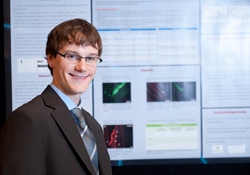 Simon Jean
Simon Jean
La sensation douloureuse fait normalement intervenir l'activation de fibres afférentes de petit calibre, connues sous le nom de nocicepteurs. Bien que plusieurs syndromes douloureux résultent du dysfonctionnement de ces fibres afférentes, d'autres syndromes ont été associés à une excitabilité accrue de fibres afférentes primaires de gros calibre dont l'activation est normalement liée à la perception de stimulus mécaniques non nuisibles. Ces observations ont mené à l'hypothèse voulant qu'une intensification de l'activité de ces grosses fibres pourrait activer les nocicepteurs par des interactions périphériques.
Nous avons voulu vérifier cette hypothèse 1) en étudiant la proximité physique des fibres de petit calibre identifiées à l'aide de marqueurs nociceptifs et des fibres de gros calibre marquées par la protéine VGlut1 – le transporteur du glutamate présent dans les nerfs qui libèrent ce neurotransmetteur; 2) en vérifiant si les nocicepteurs putatifs ont des récepteurs du glutamate et 3) en examinant la présence de canaux ioniques (CaV3.2, HCN2 et NaV1.7) sur les terminaisons périphériques des fibres afférentes des fuseaux musculaires, qui pourrait expliquer cette plus grande excitabilité.
Des essais immunohistochimiques ont été réalisés sur des rats mâles Sprague Dawley. Les anticorps primaires testés ont été CGRP, mGluR5, P2X3, PGP 9.5, TRPV1, VGLUT1, CaV3.2, HCN2 et NaV1.7.
Des nocicepteurs putatifs ont été découverts à proximité immédiate des terminaisons de fibres de gros calibre pouvant libérer du glutamate dans les fuseaux musculaires. Ces données laissent croire que le glutamate libéré par les fibres afférentes des fuseaux musculaires pourrait contribuer au recrutement des voies nociceptives par une interaction périphérique dans le muscle, ce qui pourrait mener à une douleur musculaire chronique. Les essais menés décrivent la distribution de certains canaux ioniques qui pourraient représenter de nouvelles cibles dans la recherche de produits thérapeutiques pour le traitement de la douleur musculaire buccofaciale chronique.
2e place
L'histatine 1 résiste à l'environnement protéolytique buccal lorsqu'elle est adsorbée à l'hydroxyapatite
Par : Erin McDonald, Université Western Ontario
Conseiller : Dr Walter Siqueira
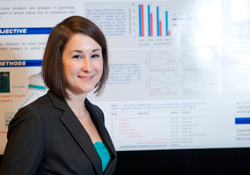 Erin McDonald
Erin McDonald
La pellicule acquise de l'émail est une couche qui se forme à la surface de l'émail par l'absorption sélective de protéines salivaires. Cette pellicule agit comme un lubrifiant ainsi qu'une barrière sélective qui régule la déminéralisation, et elle contrôle la composition de la flore microbienne qui vient en contact avec les surfaces de l'émail. Les histatines font partie d'un groupe de protéines salivaires antimicrobiennes qui ont une grande affinité pour l'hydroxyapatite (HA) et qui, croit-on, amorceraient la formation de la pellicule. Alors que l'histatine intacte est présente dans les sécrétions glandulaires, cette protéine est pratiquement absente de la salive entière en raison de l'importante dégradation protéolytique qui survient dans la cavité buccale.
Cette étude avait pour but d'évaluer si l'histatine 1 peut demeurer intacte dans l'environnement hautement protéolytique des liquides buccaux lorsqu'elle est adsorbée sur les surfaces de l'émail.
L'histatine 1 a été pré-incubée avec des cristaux synthétiques de HA pendant 120 min. À l'équilibre, les complexes histatine/HA ont été incubés dans le surnageant de la salive entière à 37 °C pendant différentes périodes de temps. L'histatine 1 liée a été récupérée après la dissolution des cristaux et elle a été analysée par électrophorèse sur gel cationique, chromatographie liquide à haute performance (CLHP) et MALDI-TOF.
L'incubation de l'histatine 1 intacte dans la salive entière a entraîné une dégradation d'environ 30 % après 30 min et de 75 % après 120 min. À l'inverse, durant l'incubation du complexe histatine l/HA dans la salive entière, une dégradation minimale (14 %) a été observée durant la période d'incubation de 120 min.
La présente étude montre, pour la première fois, que la liaison de l'histatine 1 intacte à l'HA confère à l'histatine une résistance à la dégradation protéolytique. Ces résultats ouvrent de nouvelles voies pour la conduite d'études visant à fournir des précisions sur le traitement précoce des maladies buccales, comme la carie dentaire.
Erbium lasers: toys or tools for restorative dentistry?
Par : Natasha Chishti, Université Dalhousie
Conseiller : Dr Mark Knechtel
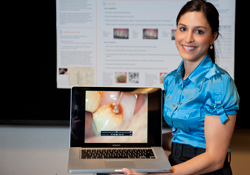 Natasha Chishti
Natasha Chishti
Modern dentistry has adopted a minimally invasive approach to caries management. Yet when cavitation occurs, a surgical approach is needed to remove the infection. At present, the high-speed handpiece is the instrument of choice for effective caries removal. This procedure has some disadvantages, such as an irritating noise, uncomfortable vibrations, stress and pain for patients and the unnecessary removal of sound tooth structure.
To overcome these disadvantages, new technologies for dental hard tissue removal, such as erbium lasers, have been developed. Since receiving FDA approval in 1997, erbium lasers have reportedly been used to successfully remove caries in all classes of cavity preparations without local anesthesia. Patients have expressed a preference for future restorative treatment with lasers instead of conventional handpieces.
The purpose of this literature review was to determine whether the marketing claims for erbium laser use in restorative dentistry are founded on solid scientific evidence and if erbium lasers confer additional benefits for patients and practitioners compared to current dental technology.
We searched the PubMed database and the Cochrane Library. Journal articles were selected based on a hierarchy of evidence, with systematic reviews of randomized clinical trials considered the highest quality evidence and case reports the lowest.
Currently there is a lack of high-quality evidence to substantiate the marketed uses of erbium lasers in restorative dentistry. The safety, efficacy and benefit of erbium laser use in restorative dentistry is questionable until manufacturer claims are supported by independent, reproducible studies published in peer-reviewed journals.
Screening for novel inhibitors of cathepsin K
Par : Michael Ho, Université de la Colombie-Britannique
Conseillère : Dr Ravindra Shah
 Michael Ho
Michael Ho
Cathepsin K (catK) has recently received considerable attention because of its major contribution to the digestion of extracellular matrix in bone remodeling, particularly in the breakdown of the collagen network. In fact, overexpression of catK is found in diseases such as arthritis, osteoporosis and invasive breast cancer. Therefore, it is important to screen for potential inhibitors of catK.
Potential inhibitors were tested in vitro by using the collagen and gelatin assay. These 2 assays will not only determine if the molecule can inhibit catK but will help determine whether the molecule will inhibit by interfering with the active site or the formation of the catK/C4-s complex.
A couple of molecules that we screened showed positive results in inhibiting catK by potentially disrupting the catK/C4-s complex. We believe this complex is required in the degradation of type 1 collagen as our lab has shown that C4-s enhances the degradation of collagen by catK.
Association between BMI and severe early childhood caries
Par : Katherine Davidson, Université du Manitoba
Conseiller : Dr R.J. Schroth
 Katherine Davidson
Katherine Davidson
Severe early childhood caries (S-ECC) is an aggressive subtype of early childhood caries affecting children < 72 months of age. These children tend to have a reduced quality of life and altered growth patterns. The objective of this study was to compare body mass index (BMI) between children with S-ECC and those who are caries-free.
Between October 2009 and June 2011, children ≤ 72 months with S-ECC requiring general anesthesia were recruited from Winnipeg on the day of their dental surgery. Age-matched, caries-free controls were recruited from the community. Children were participating in a larger study on nutrition and S-ECC. Only children ≥ 24 months were included in this substudy. Parents completed a questionnaire and the height and weight of the children were recorded. BMI scores and age- and gender-adjusted BMI percentiles were calculated according to the Centre for Disease Control guidelines. A p value ≤ 0.05 was significant.
Over 250 children took part in the larger study; 232 were ≥ 24 months and therefore included in the BMI analysis (141 children with S-ECC and 91 caries-free children). The mean age was 43.2 ± 12.9 months and 51% were males. About one-third (34.4%) of participants were either overweight or obese, more than double the proportion expected.
Of the children categorized as obese, 75% had S-ECC. Height or weight did not significantly differ between the groups. Children with S-ECC were significantly more overweight when comparing the age- and gender-adjusted BMI percentiles (69.0 ± 29.2 vs. 57.2 ± 31.6, p = 0.005). Therefore, an association between severe caries and obesity may be plausible.
An in vitro study of the efficacy of moisture-tolerant resin-bonded sealants
Par : Eric Knouse et Jill Kulyk, Université de la Saskatchewan
Conseillère : Dre Carol Nagle
 Eric Knouse et Jill Kulyk
Eric Knouse et Jill Kulyk
Traditional pit and fissure sealants have been shown to be highly effective at preventing caries. However, success can be difficult due to saliva contamination during placement. Recently, a moisture-tolerant sealant has been developed that could overcome this problem.
An in vitro comparison of traditional sealant material and moisture-tolerant sealant material was performed in both a dry and moist environment. Eighty (80) non-carious third molars and bicuspids were divided into 4 groups: those treated with traditional sealant (Ultradent XT) or moisture tolerant sealant (Pulpdent Embrace Wetbond) each in dry and moist environments. Sealants were applied following manufacturer specifications and samples were thermocycled for 2000 cycles in artificial saliva. The samples were stained using 2% methylene blue and sectioned using a slow-speed diamond saw. They were examined under stereoscopic microscope for depth of penetration of the dye under the sealant. Dye penetration was assessed on a 4-point grading system. The statistics were compiled with SPSS 17.0 and STADA for chi-square test looking for descriptive analysis for dissociation. Pearson chi-square test of combined pools of no penetration depth versus penetration was applied.
The traditional sealant placed in a dry environment was significantly more effective than the moisture-tolerant sealant placed in a moist environment. The moisture-tolerant sealant performed similarly in both dry and moist environments. The moisture-tolerant sealant both moist and dry performed much better than the traditional sealant in the moist environment. These results indicate that the traditional sealant is superior as long as a dry, isolated environment is achievable.
Assessing the change in dental students' attitudes toward the care of high-risk, underprivileged populations in a dental school community program
Par : Layal Ksaybi et Jennifer Seidler, Université McGill
Conseillère : Dre Veronique Benhamou
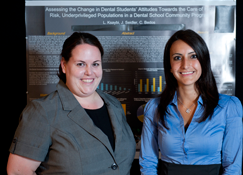 Jennifer Seidler et Layal Ksaybi
Jennifer Seidler et Layal Ksaybi
Racial and ethnic oral health disparities are a common, multifactorial problem in the Montreal region. This study described dental students' perceptions and levels of comfort and concern with treating high-risk, underprivileged patients in a university dental outreach community program throughout the 4 academic years of the DMD program. It further investigated students' future willingness to treat similar patients.
Eighty six (86) dental students from a university dental program were given a survey in which students rated responses using a 4-point scale with the objective of understanding the effectiveness of having an outreach program as a mandatory component of the DMD curriculum. It also looked at the effect it had on their attitudes toward treating high-risk population groups, and willingness to treat such patients in their future practices. Data were analyzed using the statistical SPSS 11.5 for Windows software.
It can be concluded that the level of training, including didactic knowledge, technical skills and clinical experience, may improve a student's level of comfort when treating high-risk, underprivileged patients encountered in a dental outreach program. Students enjoyed participating in the program, despite their concerns over a higher risk of disease transmission. Female students were found to be more interested in treating an outreach population in their future practice. Within the limitations of this study, it can be suggested that implementing a dental outreach community program in the university dental curriculum has a significant effect on student perception of the outreach patient population and their level of involvement in the community.
Development of antimicrobial monomer systems
Par : Mike Laschuk, Université de Toronto
Conseiller : Dr Boris Hinz
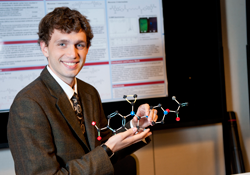 Mike Laschuk
Mike Laschuk
Antimicrobial agents used in restorative materials are primarily limited to fluoride in glass ionomer cements (GICs) or resin-modified GICs. A common challenge is controlling the diffusion of fluoride from GICs, which typically depletes their release early in the implant life. The objective was to synthesize 2 monomers with incorporated antibiotics, such as ciprofloxacin (CF), to use in the resin component of restorative composites. Such systems could provide long-term, controlled release of antibiotic activity.
CF was reacted with triphenyl chloride using triethylamine as a catalyst. Methanol was subsequently added to deprotect the carboxylic acid group. (N)-trityl ciprofloxacin was then reacted with triethylene glycol (TEG), using 4-dimethylaminopyridine (DMAP) and 1-ethyl-3-[3-dimethylaminopropyl] carbodiimide hydrochloride (EDC) as catalysts. The next phase involved deprotecting the amines, using trifluoroacetic acid and water, and the reaction of methacrylic acid with the terminal amines of the CF-component using EDC and DMAP as catalysts. The second monomer was synthesized by reacting CF with hexane-1,6-diisocyanate (HDI) in 4-dimethylsulfoxide at 60oC. In ongoing work, this product will be reacted with hydroxyethyl-methacrylate to yield the final monomer.
1H-NMR, 19F-NMR, time of flight mass spectroscopy, and thin layer chromatography were used to characterize the monomers at each step. N-protection of CF was successful, followed by coupling with TEG. The coupled product was deprotected, resulting in precipitate formation. CF-coupled HDI was also achieved and purified. The synthesis of antimicrobial monomers was achieved, and purification method development is in progress. Further work will investigate their use in coupling methacrylate agents for use in resin development.
Immigrant parents' awareness of their child's dental health status
Par : Jenny (Eun Jung) Shim, Université de l'Alberta
Conseillère : Dre Maryam Amin
 Jenny (Eun Jung) Shim
Jenny (Eun Jung) Shim
The aim of this study was to explore the level of awareness of a group of Punjabi-speaking and African parents about their children's dental health and the factors that may influence their awareness.
Participants were parents and their 3- to 6-year-old children from Punjabi-speaking and 3 African communities who had lived in Canada for 10 years or less. Parents were asked to assess their child's dental health and identify the indicators and ways they use to recognize dental caries. A dental exam was performed for children in a community location. Parental awareness was determined by comparing children's normative status (clinically measured dental health status) with parents' perceived status.
In total, 98 parents and 106 children completed the study. The mean defs were 5.8 (± 13.7) for Punjabi-speaking and 8.9 (± 11.4) for African-origin children. More than half of the children had never visited a dental office before. Almost three-quarters (73.4%) of Punjabi-speaking and 76.3% of African parents were unaware of their child's dental health including parents who did not know their child's condition at all. About 40% of parents referred to parental checking to assess their child's dental health. Parents employed limited indicators for caries detection which often referred to an advance form of this disease. Parental perception of their child's dental health did not seem to be a reliable proxy of actual status. Dental visits for preventive reasons should be promoted. Also, parents should be educated regarding indicators and effective ways of detecting caries.
Résorption osseuse suite à l'extraction d'une dent : mise en place d'un implant immédiat ou retardé
Par Sandrine Gosselin, Université Laval
Conseiller : Dr Serge Roy
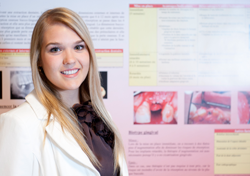 Sandrine Gosselin
Sandrine Gosselin
Le domaine de l'implantologie est en pleine effervescence. L'alternative des implants est de plus en plus envisagée dans le but d'avoir un résultat combinant esthétique et fonction. Par contre, les dentistes sont peu informés sur la perte osseuse associée aux différentes méthodes d'implantologie. Effectivement, les différentes techniques de mise en place d'implants, soit implantation immédiate ou retardée, possèdent des avantages et des inconvénients qui peuvent influencer le pronostic du traitement. Les traits physiologiques individuels, tels que le biotype gingival et la dimension verticale de la crête osseuse, ainsi que les contraintes survenues lors de l'extraction, telle une fracture de la crête, sont également des facteurs importants à considérer quant au choix de la pose d'implants.
Nous avons procédé à une revue de littérature. La littérature rapporte que 50 % de perte osseuse survient suite à une extraction dentaire. Le but de notre entretien clinique sera donc d'éclairer les dentistes sur les différentes lignes de conduite qui portent à minimiser cette perte osseuse. Ces indications pourraient-elles permettre, un jour, d'établir une procédure décisionnelle à appliquer quant à la mise en place d'un implant?
Photos : Teckles Photo Inc.
